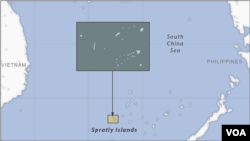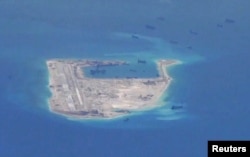Vietnam is dredging and filling out the Spratly Islands in the South China Sea, a move that appears to be aimed at countering China’s assertive behavior in the disputed waters, analysts said.
Recent Vietnamese expansion work in the Spratly Islands, which began in 2021, was most noticeable at Barque Canada Reef, according to a report last week by the Washington-based Center for Strategic International Studies' Asia Maritime Transparency Initiative (AMTI).
The report said Vietnam created 0.84 square kilometers of land in the past year.
Vietnam's reclamation work on Barque Canada Reef, known as Bai Thuyen Chai in Vietnamese, is progressing rapidly, already making it the largest Vietnam occupied feature in Spratly Islands, according to the South China Sea Probing Initiative (SCSPI), a Chinese think tank.
Since July, nearly 0.56 square kilometers has been reclaimed, and may involve building a second airfield on the Vietnam occupied features, said the Beijing-based defense group on X, formally known as Twitter, on November 22.
China claims the Spratly Islands and Paracel Islands as its own maritime territories and has been expanding military installations on the island chains.
The Chinese government-backed researchers said while China and the Philippines engage in frequent confrontations over Second Thomas Shoal, a submerged reef in the Spratly Islands, Vietnam is “quietly making some major breakthrough in the land reclamation in the Spratly Islands.” Up to now, 3.22 square kilometers has been expanded, SCSPI added.
The Chinese and Vietnamese embassies in Washington, and the foreign ministries of the two nations did not respond to VOA’s requests for comments.
In October 2023, Vietnam began new dredging at two additional outposts, AMTI said.
“The continued dredging and construction work shows that Vietnam remains very anxious about China’s militarization and coercive behavior in the South China Sea and is working to ensure it can maintain access to the reefs and waters claimed by Hanoi,” Gregory Poling, director of the AMTI, told VOA Vietnamese in an email on November 20.
“So far the construction appears defensive in nature, and it remains at a smaller scale than that of China,” he said. “But the use of cutter suction dredgers, albeit in a limited capacity, is problematic.”
A cutter suction dredge “cuts hard soil into fragments with a rotating cutter head,” according to DredgingToday. “The material is sucked up by dredge pumps and discharged to a deposit area through pipelines across sea and land.”
According to Poling, Vietnam’s use of cutter suction dredgers is much more environmentally destructive than its previous dredging methods.
According to the Wilson Center’s New Security Beat, “dredging breaks up coral reefs, disturbs ecosystems by changing wave patterns, and disrupts the migration corridor of many species through the South China Sea.”
Since AMTI last surveyed these efforts in December 2022, Vietnam has created another 1.33 square kilometers of land, bringing its total during the current spate of building to 3.0 square kilometers.
Work on the new outposts could play into Chinese information operations that seek to paint Vietnam as the real destabilizer in the disputes.
Vietnam’s expansion totals only about a quarter of the more than 12.9 square kilometers of land created by China from 2013 to 2016, but is more island expansion than any other claimant besides China has undertaken, the U.S. think tank said. Taiwan, Brunei and Malaysia also have claims to the waters.
Since 2013, Vietnam and the other claimant states have watched China build artificial islands and the international community has protested to little practical effect, according to Raymond Powell, director of Stanford University's Project Myoushu in the South China Sea, who observed recent disputes over the waters.
“At this point these features are fully militarized bases from which China effectively projects power deep into its neighbors' exclusive economic zones,” Powell told VOA Vietnamese via WhatsApp on Nov 20. “Therefore, Vietnam has drawn the conclusion that it has little choice but to respond with its own such campaign.”
Powell said that it seemed likely that other South China Sea claimants — the Philippines and Malaysia — would eventually feel compelled to take similar steps. China will doubtless draw attention to those efforts and claim that they are violations of the 2002 Declaration on the Conduct of Parties in the South China Sea, but China's flagrant, serial violation of that agreement makes it a non-credible voice on that subject, he added.
“Vietnam seems to have learned a lesson that if it could not build models to preserve the entities it is now occupying, there would be more difficulty [in doing so], Hoang Viet, an expert on South China Sea disputes at the National University of Ho Chi Minh City in Vietnam, told VOA Vietnamese via telephone on Nov 21.
“Now it is a favorable time [for Vietnam] when Vietnam's relationships with both China and the U.S. are making progress,” he said, adding, “So, Vietnam must take advantage, so that it can keep these entities that are under its control.”
Vietnam has controlled the Barque Canada Reef since 1987, but its sovereignty is challenged by China, Taiwan and Malaysia.
“China will definitely not be happy because China certainly doesn't want any country to do that,” Hoang said.
“Perhaps Vietnam also understands to what extent China's limits. Even though China is dissatisfied, China has no reason to stop Vietnam because China itself also expand a lot larger, even militarized the island,” Hoang added. “As for China being angry enough to stop Vietnam, I don't think so. And perhaps Vietnam has also calculated this situation.”













